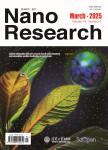Observation of coupling between zero- and two- dimensional semiconductor systems based on anomalous diamagnetic effects
Observation of coupling between zero- and two- dimensional semiconductor systems based on anomalous diamagnetic effects作者机构:Beijing National Laboratory for Condensed Matter Physics Institute of Physics Chinese Academy of Sciences Beijing 100190 China Hitachi Cambridge Laboratory Cavendish Laboratory Cambridge CB3 OHE UK Department of Physics Fudan University Shanghai 200433 China Collaborative Innovation Center of Quantum Matter Beijing 100084 China
出 版 物:《Nano Research》 (纳米研究(英文版))
年 卷 期:2016年第9卷第2期
页 面:306-316页
核心收录:
学科分类:080901[工学-物理电子学] 07[理学] 0809[工学-电子科学与技术(可授工学、理学学位)] 08[工学] 080401[工学-精密仪器及机械] 070203[理学-原子与分子物理] 0804[工学-仪器科学与技术] 0803[工学-光学工程] 0702[理学-物理学]
基 金:This work was supported by the National Basic Research Program of China (Nos. 2013CB328706 and 2014CB921003) the National Natural Science Foundation of China (Nos. 91436101 11174356 and 61275060) the Strategic Priority Research Program of the Chinese Academy of Sciences (No. XDB07030200) and the 100 Talents Program of Chinese Academy of Sciences. We thank Jean-Pierre Leburton for helpful discussions
主 题:magneto-photoluminescence InAs quantum dots wetting layer strong diamagnetic effects
摘 要:We report the direct observation of coupling between a single self-assembled InAs quantum dot and a wetting layer, based on strong diamagnetic shifts of many-body exciton states using magneto-photoluminescence spectroscopy. An extremely large positive diamagnetic coefficient is observed when an electron in the wetting layer combines with a hole in the quantum dot; the coefficient is nearly one order of magnitude larger than that of the exciton states confined in the quantum dots. Recombination of electrons with holes in a quantum dot of the coupled system leads to an unusual negative diamagnetic effect, which is five times stronger than that in a pure quantum dot system. This effect can be attributed to the expansion of the wavefunction of remaining electrons in the wetting layer or the spread of electrons in the excited states of the quantum dot to the wetting layer after recombination. In this case, the wavefunction extent of the final states in the quantum dot plane is much larger than that of the initial states because of the absence of holes in the quantum dot to attract electrons. The properties of emitted photons that depend on the large electron wavefunction extents in the wetting layer indicate that the coupling occurs between systems of different dimensionality, which is also verified from the results obtained by applying a magnetic field in different configurations. This study paves a new way to observe hybrid states with zero- and two-dimensional structures, which could be useful for investigating the Kondo physics and implementing spin-based solid-state quantum information processing.




